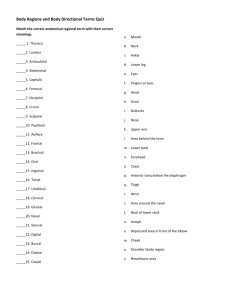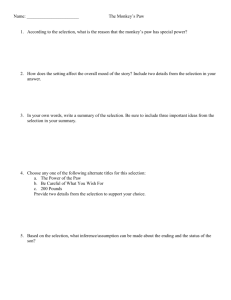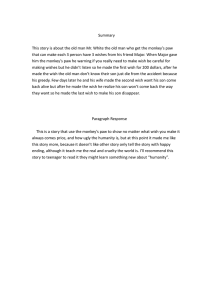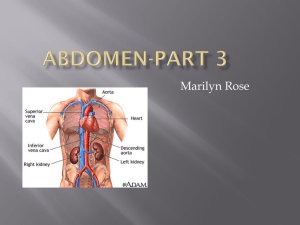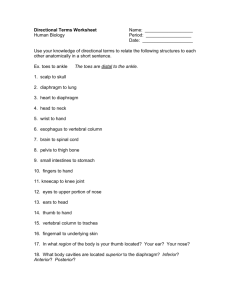Document 12481164
advertisement
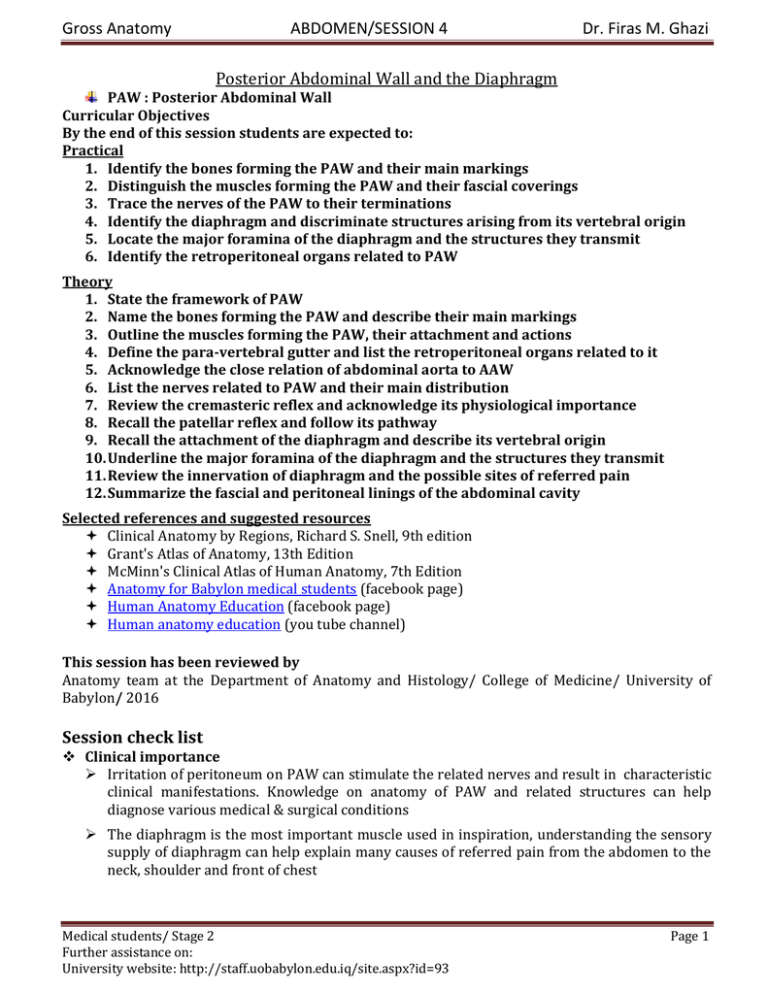
Gross Anatomy ABDOMEN/SESSION 4 Dr. Firas M. Ghazi Posterior Abdominal Wall and the Diaphragm PAW : Posterior Abdominal Wall Curricular Objectives By the end of this session students are expected to: Practical 1. Identify the bones forming the PAW and their main markings 2. Distinguish the muscles forming the PAW and their fascial coverings 3. Trace the nerves of the PAW to their terminations 4. Identify the diaphragm and discriminate structures arising from its vertebral origin 5. Locate the major foramina of the diaphragm and the structures they transmit 6. Identify the retroperitoneal organs related to PAW Theory 1. State the framework of PAW 2. Name the bones forming the PAW and describe their main markings 3. Outline the muscles forming the PAW, their attachment and actions 4. Define the para-vertebral gutter and list the retroperitoneal organs related to it 5. Acknowledge the close relation of abdominal aorta to AAW 6. List the nerves related to PAW and their main distribution 7. Review the cremasteric reflex and acknowledge its physiological importance 8. Recall the patellar reflex and follow its pathway 9. Recall the attachment of the diaphragm and describe its vertebral origin 10. Underline the major foramina of the diaphragm and the structures they transmit 11. Review the innervation of diaphragm and the possible sites of referred pain 12. Summarize the fascial and peritoneal linings of the abdominal cavity Selected references and suggested resources Clinical Anatomy by Regions, Richard S. Snell, 9th edition Grant's Atlas of Anatomy, 13th Edition McMinn's Clinical Atlas of Human Anatomy, 7th Edition Anatomy for Babylon medical students (facebook page) Human Anatomy Education (facebook page) Human anatomy education (you tube channel) This session has been reviewed by Anatomy team at the Department of Anatomy and Histology/ College of Medicine/ University of Babylon/ 2016 Session check list Clinical importance Irritation of peritoneum on PAW can stimulate the related nerves and result in characteristic clinical manifestations. Knowledge on anatomy of PAW and related structures can help diagnose various medical & surgical conditions The diaphragm is the most important muscle used in inspiration, understanding the sensory supply of diaphragm can help explain many causes of referred pain from the abdomen to the neck, shoulder and front of chest Medical students/ Stage 2 Further assistance on: University website: http://staff.uobabylon.edu.iq/site.aspx?id=93 Page 1 Gross Anatomy ABDOMEN/SESSION 4 Dr. Firas M. Ghazi Lab identifying checklist: 1. 12th thoracic vertebra and rib 2. Lumbar vertebrae: Bodies/ transverse processes/ Intervertebral discs/ Inward curvature 3. Iliac bone, iliac fossa, Arcuate line, pectineal line and Iliopectineal line 4. Sacrum/ Lumbosacral joint/ sacral promontory/ Backward curvature 5. Femur and its lesser trochanter 6. Muscles: psoas/ iliacus/ quadrates lumborum/ transversus abdominis 7. Diaphragm: central tendon/ crura/ major openings and the structures passing through 8. Para-vertebral gutters 9. Arcuate ligaments and Iliolumber ligament 10. Nerves: subcostal/ Ilio-inguinal and iliohypogastric/ lateral cutaneous nerve of the thigh/ femoral nerve/ genitofemoral nerve/lumbosacral trunk/ obturator nerve 11. Kidneys/ ureters/ abdominal aorta/ inferior vena cava/ pancreas Posterior abdominal wall Task 1 (watch and respond): Watch this video then respond accordingly https://youtu.be/ovQYBAiv8cI 1. List the bones and muscles forming the PAW 2. What forms the roof of the abdominal cavity 3. Which part of the diaphragm shares the formation of the PAW? 4. Which of the muscles of PAW pass deep to inguinal ligament? 5. What is the iliopsoas and what is its action? Fascia lining the abdominal wall Structure and extensions The abdominal and pelvic walls are lined by ONE CONTINUOUS LAYER of deep fascia This layer lie between the muscles (superficial) and the parietal peritoneum (deep) It is named according to the muscle it lines Example: Diaphragmatic fascia is that lining the abdominal surface of the diaphragm Modifications: Fascia lining the PAW become thickened to form ligaments Psoas fascia is thickened above to form _______________________ Lateral arcuate ligament is a thickening of __________________ fascia The iliolumber ligament gives attachment to to ______________________ muscle Relations of PAW What is the para-vertebral gutter? List the retroperitoneal structures related to PAW Which is nearest to AAW, the kidneys or abdominal aorta? elaborate Nerves related to PAW A. Subcostal nerve B. Lumber sympathetic trunk Run along a groove between lumbar vertebra and the psoas C. Lumber plexus (L1-L4) Task 2: review the nerves of lumber plexus then answer the following questions 1. Which of these nerves pass from the lateral border of the psoas muscle? 2. List the nerves passing to the thigh and name the area they supply 3. List the nerves passing to the pelvis and outline their final distribution Medical students/ Stage 2 Further assistance on: University website: http://staff.uobabylon.edu.iq/site.aspx?id=93 Page 2 Gross Anatomy ABDOMEN/SESSION 4 Dr. Firas M. Ghazi Diaphragm Task 3: using lab resources, run through the following tasks to review the diaphragm □ Locate the diaphragm. Notice its two domes. Which cavities are separated by the diaphragm? □ □ □ □ View its abdominal surface. Identify its muscular part & central tendon with its three leafs Distinguish the different parts of origin of the diaphragm and identify the vertebral part Identify the three major openings of diaphragm and list the structures passing through At what vertebral levels lie these three openings Notice the muscular loop around the esophageal hiatus What is the function of the slinglike loop around the esophageal hiatus? Peritoneal Lining of the Abdominal Walls Peritoneum is a serous membrane within the abdominal cavity Abdominal walls (anterior & posterior) & diaphragm are lined by parietal layer of peritoneum 1. Nerve supply The parietal peritoneum is supplied by somatic nerves supplying the walls of the abdomen Which part of the abdominal peritoneum is not supplied by segmental spinal nerves? Review questions A. Regarding the lumber plexus 1. List the nerves providing sensory supply to the lower limb and the regions supplied 2. Which of its nerves is responsible for the patellar reflex, which spinal segments involved? 3. What is the cremasteric reflex? Name the nerves involved B. Regarding the diaphragm Its movement is supplied by _________ nerve which arises from ________ spinal cord segments Its abdominal surface has dual somatic sensory supply, explain. Comprehension questions 1. Explain why the femoral sheath contain the femoral vessels but not the femoral nerve Hint: Tracing the abdominal fascia down to inguinal region may help 2. The deep inguinal ring is a perforation in which of the following abdominal fascia A. Psoas fascia B. Iliacus fascia C. Quadratus lumborum fascia D. Transversalis fascia E. Femoral sheath 3. A 55 years old male with history of dry cough for the last 2 months presented with sudden attack of difficulty in breathing. There was decreased breathing sounds on the right side during examination. Chest X- ray revealed the right hemi-diaphragm at the level of fourth rib. A. At which level the diaphragm usually found during inspiration on the right and left sides? B. What causes the diaphragm to reach this level in this case? Homework: There is a dens network of lymphatic capillaries on the abdominal surface of diaphragm. 1. What is the physiological importance of this network? 2. What are the medical conditions that usually spread via this network? Medical students/ Stage 2 Further assistance on: University website: http://staff.uobabylon.edu.iq/site.aspx?id=93 Page 3
